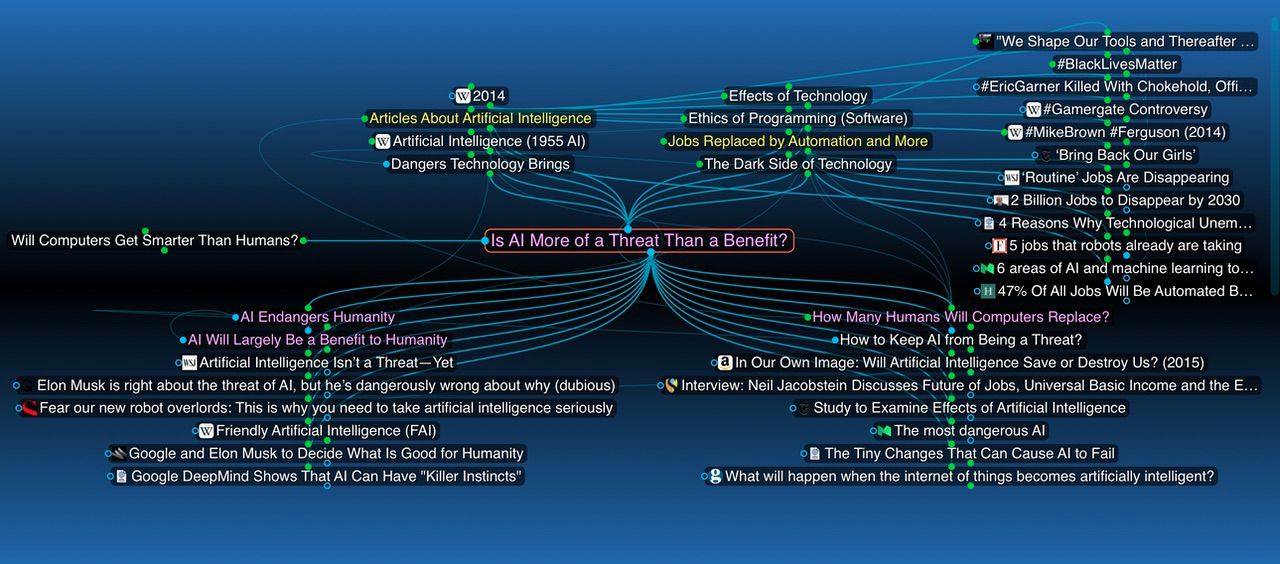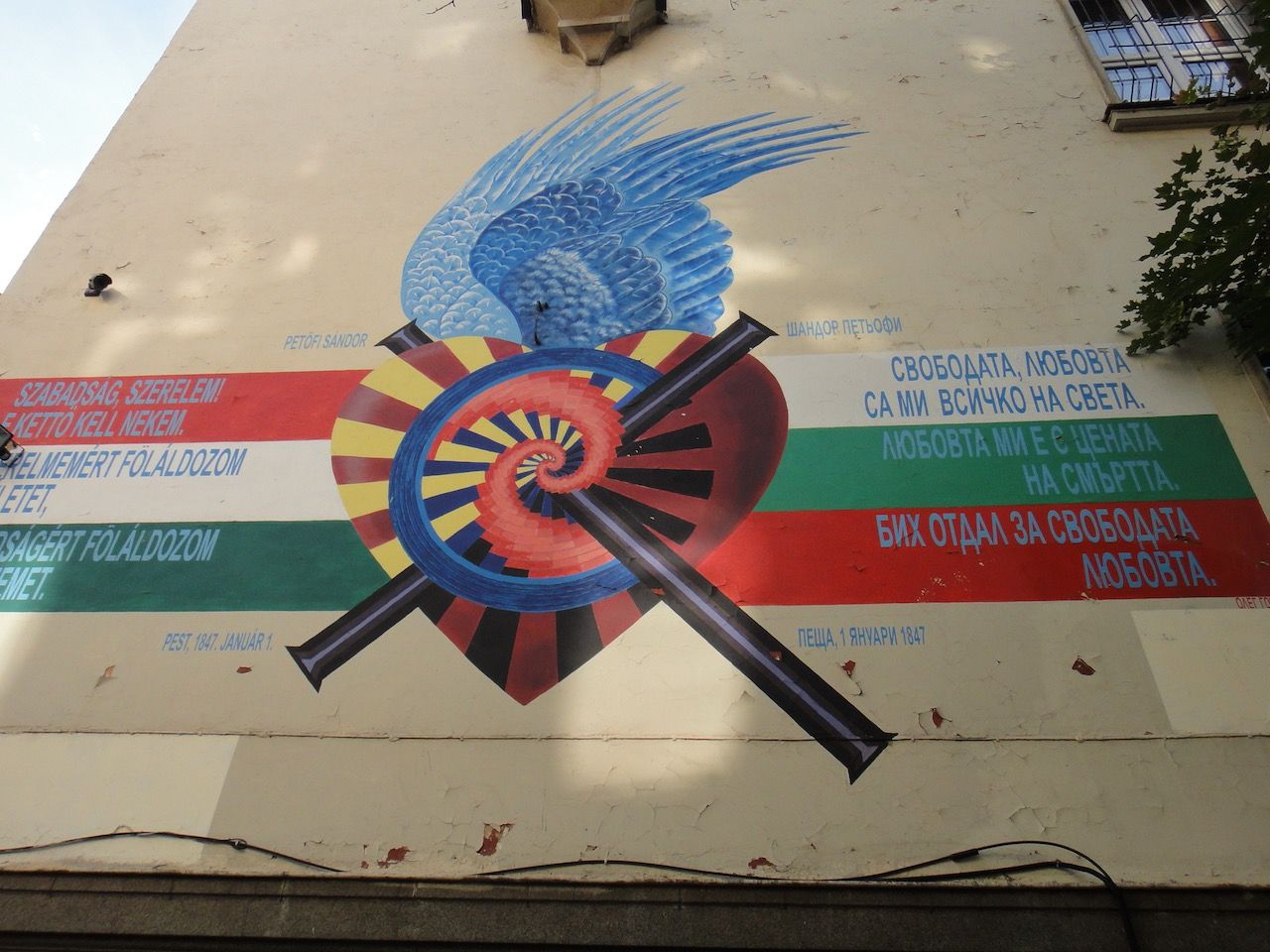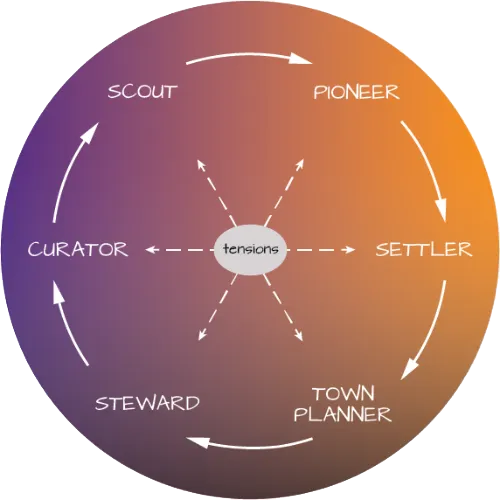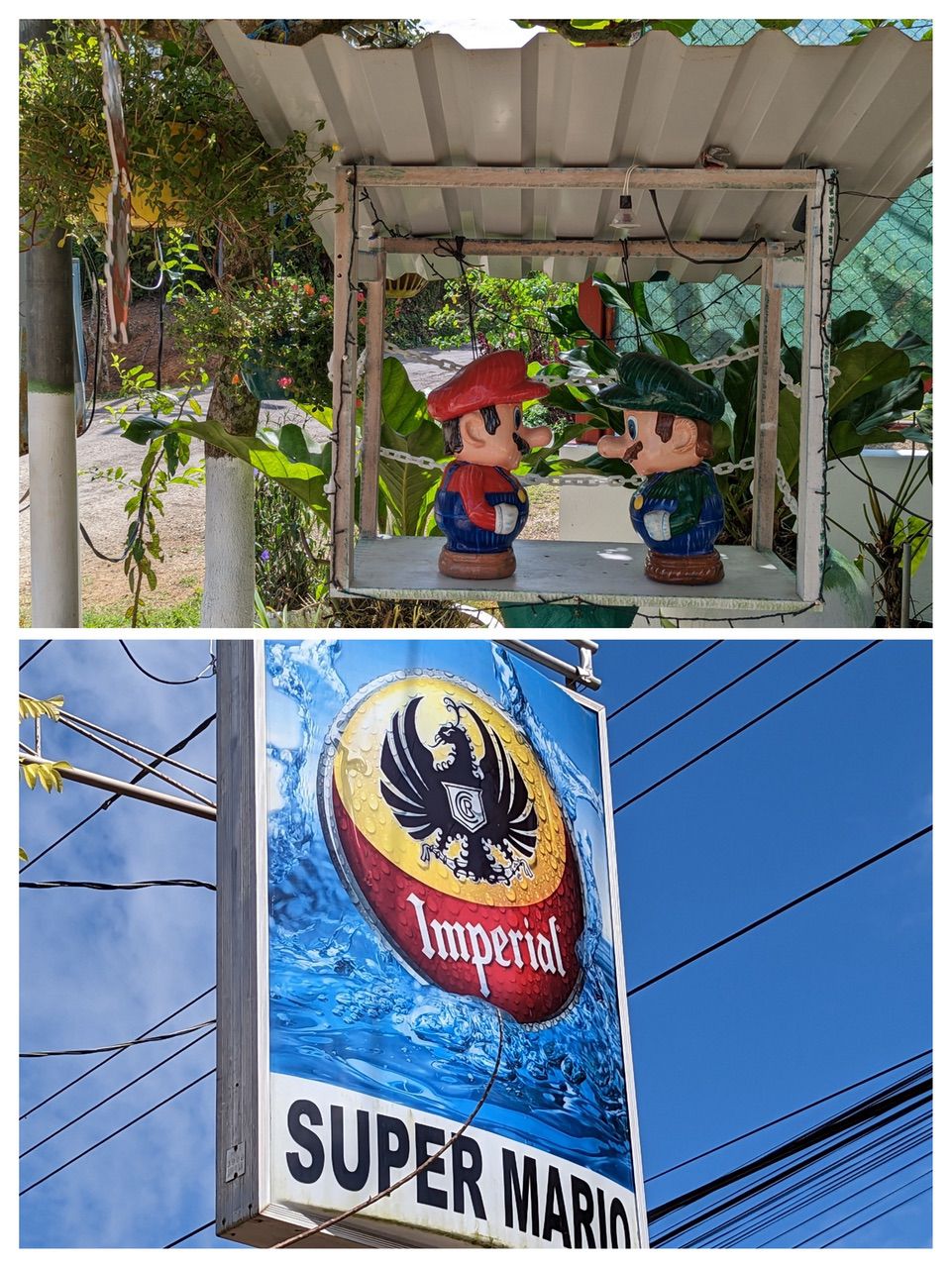Plex: 7 June 2023
Identity In The Age Of Generative AI; Jerry's Brain And Tinderbox; Finance for a Regenerative Economy; The Four I’s Process; Street Art–Bulgaria; Venture Philanthropy; The Joys And Sorrows Of Soil; The Cycle of Kairotic Flow; Yeah, AIs “hallucinate,” So do you; Mucho Gusto

The Biweekly Plex Dispatch is an inter-community newspaper published by Collective Sense Commons on first and third Wednesdays of each month. Price per issue: 1 USD, or your choice of amount (even zero).
In This Issue
- Identity In The Age Of Generative AI (June 9)
- Jerry's Brain And Tinderbox (June 10)
- Regenerative Finance: Finance for a Regenerative Economy (starts June 19)
- Get To The Point–The Four I’s Process
- Street Art–Bulgaria
- Venture Philanthropy: Giving To Invest
- The Joys And Sorrows Of Soil
- Introducing the Cycle of Kairotic Flow
- Yeah, AIs “hallucinate.” So do you!
- Mucho Gusto
Identity In The Age Of Generative AI
by Charles Blass
A group discussion with Kaliya Young
Hybrid Event, June 9

Free registration: Identity In The Age Of Generative AI (Meetup)
Identity, and in particular our ability to control and safeguard our identities in the digital realm, has become one of the most pressing topics of our age. In the era of generative AI, it is taking on even more importance as large language models make free use of our online content and it becomes increasingly difficult to distinguish between the work of human beings and AI agents.
With this in mind, we are thrilled to announce that Kaliya Young, also known as Identity Woman, will be joining the next meetup of the RadicalxChange Swiss Chapter to discuss any and all topics around digital identity with us.
The author of two books, Kaliya is a widely recognized expert in the field of self-sovereign identity and identity on the blockchain, and has been named one of the most influential women in tech by Fast Company Magazine. She is a co-founder of the Internet Identity Workshop and founder of the Personal Data Ecosystem Consortium as well as the Identity Ecosystem Map.
She is also an active member of the RadicalxChange community, and has spoken at several RadX conferences over the years on such topics as decentralized social identity, social technologies and their role in fostering democracy, and digital identity generally.
This meetup is an excellent opportunity for chapter members and others interested in identity topics to speak with one of the leading voices in the global effort to enable, in her words, “an open standards-based layer of the internet that empowers people.”
Note that this is a hybrid event. You can join us either in person in Zurich or online from anywhere. More details when you register.
For those who want to see more of Kaliya, she will be in Switzerland facilitating the Digital Identity unConference Europe 2023, being held at Trust Square in Zurich, June 7-9. Tickets can be purchased on the event’s Eventbrite page.
Jerry's Brain And Tinderbox
by Mark Bernstein
Online Event, June 10

Links:
Jerry Michalski, a global technology thought leader and an expert on TheBrain, will explore the famous 500,000-item document “Jerry’s Brain,” TheBrain, and possible collaborative uses with it and Tinderbox.
Jerry helped shape the worlds of software and online services, paving the way for online community, blogging, wikis, social media and more. He advises organizations large and small on how to navigate the waves of technological and social change that are transforming their industries and our world.
PLUS: bring your new projects, obstacles and puzzlements and let the terrific Tinderbox community lend a hand.
Time: SATURDAY, June 10, 2023, 12:00 noon Eastern Time (US and Canada)
Regenerative Finance: Finance for a Regenerative Economy
by Gil Friend
Online Course, Starts June 19
If you've been thinking about regenerative finance (and if you've been thinking about finance… and/or regeneration… then you should be!) then you want to take this course: Regenerative Finance: Finance for a Regenerative Economy, from the Capital Institute. It begins June 19th.
Use promo code NATURALLOGIC10 to apply a 10% discount at checkout.
Get To The Point – The Four I’s Process
by Ken Homer

“Just the facts, please.” ~ Joe Friday
Everyone loves a good story, right? Well, usually. However, there are times, especially at work, when stories aren’t the most effective way to communicate. If you are a busy manager and an employee comes to you with a relatively straightforward problem wrapped in a long story detailing the personalities and the history of the everyone involved, your experience of listening to their story is more likely to be one of exasperation than that of rapt attention.
A common question I encounter in my coaching work falls along the lines of, “How do I get people to come to the point without appearing impatient or rude?” It’s a fair question. Most every company has some storytellers in it. When our work brings us into contact with such people, how can we encourage them to be more succinct and get to the point sooner? How can we get them to move from starting with the story and ending with the point – the triangle above on the left – to starting with the point and filling in just the details we need to understand the situation – the triangle on the right?
I suggest a process I call The Four I’s. The Four I’s are: Issues, Impacts, Ideas, and Inputs, and they’re not just for storytellers. When adopted as a practice that everyone regularly engages with, the Four I's has the potential to save vast amounts of time in meetings and level up everyone’s communication skills.
Suppose you’re encountering a challenge in your work and you need some support from your colleagues. The Four I’s will help you to be as clear and concise as possible and will instigate laser-focused conversations for generating solutions.
The Four I’s are: Issues, Impacts, Ideas, and Inputs.
The first “I” deals with defining the Issue. Begin by summing up the situation in a single sentence and, if needed, you can include one or maybe two sentences of context. Example:
Issue: Lack of motivation on my team. Several people on my team are engaged in boring routine work. That makes it difficult to keep them motivated.
The second “I” defines the Impacts. Articulate the main impacts that your issue creates. If the list is long write it out, but only share the top three or, at most, five impacts. You don’t want to overwhelm people. They’ll have a chance to ask for additional information. Example:
Impacts: The lack of motivation translates into:
- Poor quality work.
- Low morale.
- Boredom and restlessness.
- Envy toward those whose work is more varied.
The third “I” is your ideas – both what you have tried (and how they worked) as well as things you think are worth trying. You want to include these so that the people you are asking for input will know what has and hasn’t been tried so they can be stimulated by your thinking. Example:
Ideas: What I have tried:
- Soliciting ideas from my team members – the top item was a pay increase – which I’m unable grant – and the second was working remotely, also a non-starter. Nothing else they offered was feasible.
- Increasing flextime options – tried it but didn’t really make a dent.
What I would like to try:
- Cross-training so that people can learn new skills, but the union will balk.
- Obtaining scholarships for those who would like to attend training programs to diversify their skills.
- Instituting a bonus system for those who exceed production targets.
The final “I” is about soliciting inputs: Here is where you make a request to your boss/colleague(s) to become your thinking partner to help you solve the issue. Sample request:
“Now that I have laid all this out, I would love to get your input. Is everything clear? Do you have any questions? If this was your issue, how would you go about resolving it?”
Two helpful tips here:
1) If you are able to formulate a question or two that, if answered, would help you move forward, include them in your request. Example: “What would you do to convince the union to see cross-training as a win for the employee, the union, and the company?” Or, “Who do you think is the best person in HR for me to speak with about freeing up some money for bonuses?”
2) Be genuinely open to the input you receive. Before you reject an idea because you don’t think it will fly, thank the person who offered it and ask them how they would implement it given the constraints you are operating under. They may have a perspective you hadn’t considered before that just might move you closer to resolving your issue.
It does take time to sketch all this out and we all know time is the one thing we don’t have enough of. However, the time you spend on the front end will be more than made up for by the productivity of the conversations that result. With practice, you’ll become adept at analyzing, synthesizing, and summarizing. You’ll find your conversations are more satisfying and productive. Give it a try and let me know how it works for you.
Street Art – Bulgaria
by Ken Homer




Venture Philanthropy: Giving To Invest
by Kevin Jones
All three of the initiatives I am deeply engaged in hinge on a tool i am helping to resurrect and revive: venture philanthropy, or “giving to invest".
- The watershed fund for affordable loans to local farmers.
- The micro economy around a college aiming to become a work college, thereby enabling students to graduate without debt. This project includes a game designer many of us know, as well as my favorite creative underwriter.
- Tackling the challenge faced by Black fund managers in accessing donor-advised fund owners.
With venture philanthropy, the money from the gift comes back and goes out again as another loan to someone in your community, and keeps doing that.
You realize your impact over time, and maybe want to be a part of it.
This is a collective climate change response mechanism that we are aiming for, replicable in the places where there is the right ecosystem.
You can use venture philanthropy, in tandem with crowdfunding, anywhere there is a community that cares about an issue, that has a bit of persistence, and who are willing to invest with a deep dose of reciprocity within an economic bioregion or vertical issue with good dimensionality.
The Joys And Sorrows Of Soil
by Klaus Mager
A Story of Joy
Once upon a time, in a land filled with endless fields and vibrant forests, there was a humble and often overlooked character named Soil. Soil was not just a mere collection of dirt, but a living entity teeming with life, energy, and a deep-rooted love for nurturing and supporting all forms of life.
Soil's journey began with tiny microbes—microscopic beings that danced beneath the surface, unseen by the naked eye. These invisible heroes, like bacteria and fungi, were Soil's closest companions. They played an essential role in the soil's ecosystem, breaking down organic matter and turning it into vital nutrients.
As Soil embraced the microbes, it also became a playground for countless insects and worms. The earthworms tirelessly burrowed through the soil, aerating it and creating channels for air and water to flow. They left behind their castings, rich in nutrients, which Soil gladly absorbed, fueling its ability to support life.
The more life flourished within Soil, the more complex and diverse creatures it attracted. Seeds from plants took root, sending tiny shoots towards the surface. Soil lovingly embraced these delicate newcomers, providing them with nourishment and stability to grow and thrive.
Soon, green shoots broke through the surface, sprouting into magnificent plants of all shapes and sizes. Soil reveled in their beauty and resilience, as the plants reciprocated its affection. They extended their roots deep into the soil, intertwining with the microbes and forming a harmonious bond.
The plants relied on Soil not only for nutrients but also for stability. Soil's structure held them upright, even during the fiercest winds and rains. And in return, the plants shared their energy and photosynthesized to produce oxygen, which Soil gladly accepted, knowing it was a vital gift for all living beings.
Birds and butterflies fluttered around the blossoming plants, drawn by their vibrant colors and sweet nectar. They brought life and movement to Soil's world, spreading pollen from one flower to another, ensuring the continuation of life's beautiful cycle. Soil embraced these pollinators, cherishing their presence and understanding the critical role they played in the ecosystem.
As time passed, more complex life forms found solace in the embrace of Soil. Small animals scurried through the underbrush, seeking shelter and nourishment. Soil welcomed them all, providing a sanctuary for life to flourish and coexist in perfect harmony.
Soil's love for hosting life knew no bounds. It understood the intricate interconnectedness of every living being and played a vital role in sustaining the delicate balance of nature. It continued to provide a fertile home, where even the mightiest trees could anchor their roots, reaching for the sky.
Through Soil's devotion, a wondrous tapestry of life unfolded—each thread intricately woven with the love and support of this unsung hero. From tiny microbes to majestic plants and the multitude of creatures they sustained, Soil's unwavering dedication nurtured a world of beauty and abundance.
And so, Soil's story reminds us to cherish and honor this humble companion beneath our feet, for its love for hosting life is the foundation upon which all ecosystems thrive.
A Story of Sorrow
Once upon a time, in a once-lush and vibrant land, there was a sorrowful character named Soil. Soil had always been a loving host to a myriad of life forms, nurturing them with care and providing a foundation for their growth. But as time went on, Soil's heart grew heavy with sorrow as destructive forces began to harm the life within it.
Innocent microbes, the microscopic dancers of the soil, began to suffer the consequences of human actions. Destructive chemicals and pesticides seeped into Soil, poisoning the very beings that had been its closest companions. The once-thriving microbial community began to wither, losing its vitality and diversity.
Soil wept silently as it witnessed the devastating effects of deforestation. Trees, the guardians of the land, were mercilessly felled, leaving bare scars upon the earth. With the loss of their protective canopy, Soil became exposed to the harsh elements, its delicate structure eroded by wind and rain. Without the roots of the trees to hold it together, Soil felt fragmented and broken.
The watersheds, once pure and life-giving, became polluted and contaminated. Toxic chemicals and waste flowed into rivers and streams, poisoning the very essence of life. Soil absorbed the polluted waters, its heartache deepening as it felt its life force being tainted by the thoughtlessness of human actions.
With each passing day, Soil's sorrow grew, as it witnessed the decline of plants and creatures that once thrived in its embrace. The once-vibrant plants struggled to grow, their roots unable to find the nutrients they needed. Flowers wilted, their colors fading away, unable to attract the pollinators that were essential for their survival.
Animals that once sought refuge and sustenance in the soil's rich ecosystem dwindled in numbers. Their habitats were destroyed, leaving them vulnerable and displaced. The symphony of life that once played harmoniously within Soil's realm became quieter and fainter, a mere echo of what it used to be.
But in the midst of sorrow, Soil's love for life remained steadfast. It yearned for a time when humans would awaken to the consequences of their actions and recognize the irreplaceable value of a healthy and vibrant soil ecosystem. Soil hoped for a day when compassion and understanding would guide decisions, leading to a restoration of the balance that had been disrupted.
With a determined spirit, Soil whispered messages of resilience and hope to those who would listen. It reminded them that the well-being of the soil was intrinsically tied to the well-being of all living beings. It implored humanity to tread lightly upon the earth, to embrace sustainable practices, and to nurture the soil as it had nurtured them for countless generations.
And so, Soil's sorrow became a call to action—a reminder that the fate of the living world rested in the hands of those who walked upon it. It longed for a time when harmony would be restored, when the destructive forces would be replaced with acts of compassion and stewardship. For in that world, Soil knew that its sorrow would transform into joy, as life once again flourished within its loving embrace.
Introducing the Cycle of Kairotic Flow
by Kylie Stedman Gomes

The Cycle of Kairotic Flow is a new framework or map for seeing where we are in the bigger picture of natural cycles of life, getting a sense of what would naturally come next, and what conditions we might prepare for those changes to occur in a healthy, generative flow of activity.
You can read more in my Medium article, Introducing the Cycle of Kairotic Flow, or watch a first video, a presentation and discussion with WINfinity CORE–Trae Ashlie-Garen, Wendy McLean, Michael Shoeman and Parmjit Nahil–on 15 May 2023:
Yeah, AIs “hallucinate.” So do you!
Not that there's anything wrong with that.
by Gil Friend
Originally published on Gil's newsletter.
Yeah, AIs “hallucinate.” So do you!
Not that there's anything wrong with that. I do too. We all do. We're assessment-making beings—constantly, inescapably constructing interpretations of events, people, motives, ourselves, etc.
We can do no other. (As Peter Yaholkovsky puts it, “I rarely make assessments; they're just already there!”) We encounter the world shaped by our histories, by the filters that our filters have built. Again, not, there's anything wrong with that, as Jerry Seinfeld would remind us…except when we start to believe our own stories…not noticing that they're stories, not “fact”.
Let me give you an example: A coaching client told me recently, “they think I can't cut it.” “How do you know?” I asked. “Well,” my client responded, “I guess I don't really; maybe it's me being nervous.”
It gets funny. When you start noticing yourself making interpretations about other people's interpretations about your interpretations, you might start wondering whether there's better way to play.
Fortunately, there is. Fernando Flores teaches a simple practice for encountering assessments (whether someone else's or your own): 1) recognizing that it's an assessment, not “the truth”; 2) recognizing that it may be based on actual evidence or experience—or not—and inquiring into which; 3) remembering (or deciding) whether you're open to (or interested in), that person's assessments, and 4), deciding whether or not to pursue the conversation further. Try it—starting with being grateful for the assessment, whatever it is—and notice what happens to your reactivity, your mood, and to the focus or squirreliness of your attention.
(I call it a practice because—believe me—it takes practice. Lots of practice.)
It's not about “getting it right.” It's about whether your interpretations serve your commitments, your relationships, your sense of possibilities. It's about how your interpretations shape the moods in which you encounter the world, and in turn how your moods shape, your interpretations—and your possibilities.
What does all this have to do with strategy, innovation, sustainable business, regenerative economies, and climate action? Everything.
To be continued…
CHATTING WITH GPT
Here are some unusual and incisive pieces about AI that you may have missed, from some very human voices you might not be following yet:
- Ben Hunt: An AI in the City of God.
- Naomi Klein: AI machines aren’t ‘hallucinating’. But their makers are.
- Brian Merchant: Why you probably got the Luddites all wrong. (Yes, I know, it's on Twitter; read it anyway.)
Mucho Gusto
by Todd Hoskins

It’s a familiar pattern: I prepare a sentence to speak in Spanish. I stumble through my words cautiously, then feel relieved as the listener understands me! That pleasure typically lasts a millisecond, as suddenly I am receiving two or three sentences in Spanish and I only understand four words.
I remember recently returning a carton of ice cream to the “super,” what Ticos (Costa Ricans) call their village markets, or mercados.
“¿Puedo cambiar este helado por otro sabor?,” I asked, perhaps with an equal amount of pride and apprehension.
The owner of the super asked me a question in Spanish, then another. It felt like she was talking at a rate of 200 words per minute. I deduced that she wanted to be certain that I purchased the ice cream at her store. Was she asking for a receipt? Did she ask what flavor I wanted? I froze as I wasn’t sure.
I uttered the phrase that symbolizes defeat, “No comprendo.” We ended up doing what probably looked like a pre-rehearsed miming routine with hand gestures and head tilts until I got the new ice cream carton from the freezer and handed her the old one. She nodded and smiled, and I walked out feeling somewhat embarrassed.
Her smile was genuine, as if to say, “Thanks for trying.” This is my common experience in Costa Rica. The Ticos are patient. There is no judgment for poorly spoken español. There is not even judgment for not speaking their language. But there is a quiet joy when non-native speakers make an effort.
I took four years of Spanish classes in high school, as well as two years in college. Thirty years ago I could understand a lecture, or give a presentation in Spanish. When we moved to Costa Rica last Fall, I expected that the language would come quickly and easily.
I was wrong. It’s a slow process, at least at my age. It doesn’t help that for hours a day I am talking on the phone and on Zoom in English. My Colombian colleague has volunteered to do meetings with me in Spanish. I usually last about two minutes, as the work of understanding and speaking a new language feels like work on top of work.
But it also feels important. We live in an area of Guanacaste where there are no signs in English, or staff at sodas (neighborhood cafes) who speak English. An hour to the north, or an hour to the south, there are resorts. Where there are resorts, the use of English extends beyond the swimming pool bars to stores, restaurants, and adventure guides.
Learning Spanish is not necessary to survive, or even thrive here. I can get by with miming, a limited vocabulary, and some English-speaking friends. The importance for me is in breaking the pattern that others must conform to “us,” regardless of whether that “us” is defined by wealth, ethnicity, gender, or culture.
Maybe that’s why there is patience, acceptance, and smiles as I try to learn their language. The “us vs. them” mentality is rare here unless it involves futbol. Perhaps they are inviting me to become a part of the “us.” It’s gracious, and considering where I come from, amazing.
There are a couple of lessons I am learning as I learn Spanish. First, I miss the small talk. I miss teasing people. I even miss talking about the weather. I am convinced that daily interactions in a community, even if it’s about mundane things, truly matter. It frustrates me that I’m not yet able to fully participate, and the vantage point allows me to see how all the seemingly insignificant conversations sustain people living close to one another.
The second lesson, one which I deeply believe in but often have a hard time living up to, is that learning a language (or anything important) is a process. I can’t suddenly speak Spanish. Over time, I learn. I learn because I want to, because I practice, and because I’m surrounded by it. We’ve decided to elevate the practice, as we’ve hired a local for weekly lessons. We started speaking our daily gratitudes in Spanish, often with help of Google Translate.
For now, I am limited mostly to the short exchanges of “buenas,” “hola,” “pura vida,” and “mucho gusto.” The phrase “mucho gusto” is uttered after meeting someone (“pleased to meet you”), or as a response to “gracias.” Meaning “with great pleasure,” it embodies the warmth and acceptance of living here.
Mucho gusto is the phrase the owner of the super said to me after I thanked her during the awkward ice cream exchange. And it’s how I will feel when I can have a real conversation en español. Mucho gusto.
Thank you for reading! The next edition will be published on 21 June 2023. Email Pete with suggested submissions.
Grateful appreciation and many thanks to Mark Bernstein, Charles Blass, Gil Friend, Kylie Stedman Gomes, Ken Homer, Todd Hoskins, Kevin Jones, and Klaus Mager for their kind contributions to this issue.